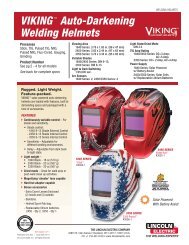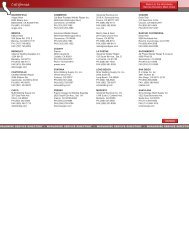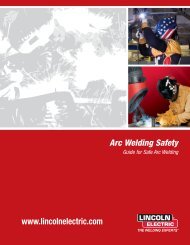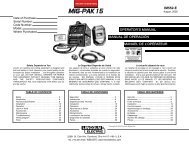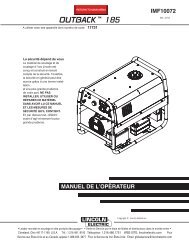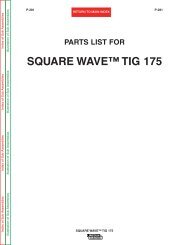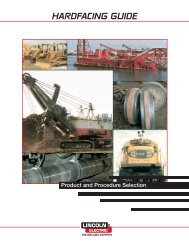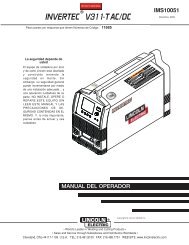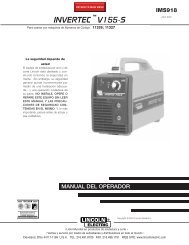Innershield Welding Guide (pdf) - Lincoln Electric
Innershield Welding Guide (pdf) - Lincoln Electric
Innershield Welding Guide (pdf) - Lincoln Electric
You also want an ePaper? Increase the reach of your titles
YUMPU automatically turns print PDFs into web optimized ePapers that Google loves.
3. Increasing WFS also increases the maximum voltage which can<br />
be used without porosity. Lowering the WFS requires lowering<br />
the voltage to avoid porosity.<br />
As the WFS is increased, the arc voltage must also be increased to<br />
maintain proper bead shape.<br />
Travel Speed<br />
OPERATING GUIDE<br />
If arc voltage, WFS and CTWD are held constant, travel speed<br />
variations have the following major effects:<br />
1. Too high a travel speed increases the convexity of the bead<br />
and causes uneven edges.<br />
2. Too slow a travel speed results in slag interference, slag<br />
inclusions and a rough, uneven bead.<br />
Contact Tip to Work Distance (CTWD)<br />
If the voltage and wire feed speed setting and the travel speed are<br />
held constant, variations in CTWD have the following major effects:<br />
1. Increasing CTWD reduces the welding current. Decreasing<br />
CTWD increases current.<br />
2. Increasing CTWD reduces actual arc voltage and results in<br />
more convex beads and reduces the tendency of porosity.<br />
3. Momentarily increasing CTWD can be used to reduce<br />
burn-through tendency when poor fitup is encountered.<br />
WELDER QUALIFICATION TEST<br />
1. Remove mill scale and other contaminants from mating<br />
surfaces of backing and test plates.<br />
2. Preheat to 300°F for 3/8” (10 mm) thick welder qualification test.<br />
3. Attach backing so that it is tight (NO GAP)<br />
4. Use the least drag angle to keep the slag back from the arc.<br />
5. Aging at 220°F, (104°C) for 48 hrs. is permitted by AWS<br />
A5.20-95, paragraph A8.3. A naturally aged specimen may<br />
take months to achieve the specified properties.<br />
Because design, fabrication, erection and welding variables<br />
affect the results obtained in applying this type of<br />
information, the serviceability of a product or structure is<br />
the responsibility of the builder/user.<br />
– 27 –



